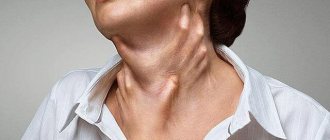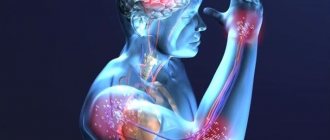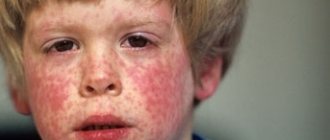Psychogenic shortness of breath - where does it come from?
Dyspnea is a disturbance in the frequency, rhythm and nature of breathing. There are pathological and nervous types.
With pathological shortness of breath, the cause lies in the disruption of the internal organs.
Psychogenic or nervous dyspnea develops primarily against the background of mental and nervous disorders:
- acute or chronic stress;
- psychogenic childhood - perhaps in childhood a person witnessed the occurrence of an attack of suffocation for various reasons. For example, a picture of drowning is accompanied by a convulsive swallowing of air by the drowning person, a characteristic facial expression;
- neurasthenia, neurosis, hysteria;
- depression;
- phobias, anxiety disorders;
- disorders of the autonomic nervous system – neurocirculatory dystonia;
- sleep disorders.
The symptom is difficulty breathing. It becomes superficial, with complicated short inhalations and long exhalations. His pace quickens, and even if a person manages to take a deep breath, it does not bring him much relief. This work of the lungs is called the breathing of a driven dog.
After uncontrolled accelerated respiratory movements there is a pause, and after it, convulsive breathing returns. All this causes anxiety and fear of approaching death in a person. A panic attack often occurs.
Distortion of the respiratory rhythm causes hyperventilation of the lungs and tension of the intercostal muscles. Because of this, false signs of angina pectoris and cardioneurosis develop. The patient is accompanied by weakness and malaise, excessive sweating, dizziness, cold extremities and convulsions.
Naturally, such symptoms suggest a heart disease, but it’s all about nervous tension.
Other signs of neurotic shortness of breath include:
- feeling of constriction in the chest;
- feeling of lack of air;
- control over the breathing process;
- feeling of a lump in the throat;
- attacks of neurotic cough - it becomes dry and annoying;
- nervous yawning;
- pain in the intercostal spaces;
- reflex movements to open the chest, which should help you take a breath - swinging your arms, straightening your shoulders, but they do not bring results;
- fear of death.
Nervous shortness of breath worsens a person’s mental state. It can cause depression, hypochondria, and mood disorders.
How to understand that you need a doctor's help
It is not always possible to independently determine the causes of shortness of breath during exercise or at rest. A pulmonologist will help with this; you should make an appointment with him if you experience shortness of breath and have trouble breathing . In case of an acute sudden attack with a significant deterioration in well-being, the patient needs emergency help. If you are concerned about shortness of breath and lack of air without exercise , then you need to visit a doctor as planned.
At your appointment, the pulmonologist will ask a number of questions, the answers to which will allow you to determine the exact cause of shortness of breath when walking , exercising, or at rest. List of main questions:
- how long has the symptom bothered you?
- severe shortness of breath occurs when walking and running or bothers you even when resting;
- which is more difficult - inhalation or exhalation;
- will the condition stabilize if you lie down;
- Are there any accompanying symptoms?
Development mechanism and distinction criteria
Each activity, including breathing, is regulated by a specific part of the brain. In a state of stress and nervous overstrain, the central and peripheral nervous systems fail. Control over the breathing center in the brain is lost, overexcitation spreads, resulting in faster breathing.
The lungs become overfilled with air, causing hypocapnia, that is, the amount of oxygen in the blood increases excessively, and carbon dioxide decreases below normal. This imbalance of gases causes an attack of psychogenic shortness of breath.
Despite the fact that the symptoms of its manifestation are similar to true shortness of breath, there are still some criteria that allow it to be differentiated:
| Types of shortness of breath Criteria | Psychogenic | True |
| Cause | Examination of internal organs fails to detect | Pathology of the heart, kidneys, lungs, etc. |
| Bodily symptoms | None | Pale or cyanotic skin, barrel chest, edema |
| Changing body position | Does not affect breathing pattern | A change in position can alleviate or provoke a pathological symptom. It often intensifies especially after physical activity. |
| Nature of violations | Fickle | Constant |
| Periodicity | It worsens due to the weather, at certain times of the day (for some, attacks occur in the morning, for others - at night). It appears more often in spring and autumn. | |
| Cough | Not controlled by medications | In some cases, it can be treated with medication |
| Switching attention | All symptoms go away if you move the conversation in a different direction | Shortness of breath persists, no connection |
Causes of shortness of breath
Experts identify 5 main causes of shortness of breath.
Heart disease is especially often manifested by shortness of breath in older people. Insufficiently active work of the heart muscle affects the supply of oxygen to the brain. The body tries to compensate for its deficiency by more actively using the respiratory system.
This may be a manifestation of coronary heart disease, angina or heart failure. Cardiac dyspnea often appears at night and is extremely difficult for patients. In this case, the most common cause is cardiac asthma.
Among vascular diseases, shortness of breath is caused by pulmonary embolism. The resulting blood clot (thrombus) partially blocks the artery, which causes a lack of air when breathing.
Respiratory diseases are the second most common cause of lack of air. Lung tissues may be affected by pathology (pneumonia, pleurisy), and the bronchi may be narrowed (bronchial asthma). This causes little oxygen to enter the blood.
Anemia is characterized by a lack of red blood cells and hemoglobin in the blood. And these are the particles that distribute oxygen throughout the body.
Neurosis also often causes symptoms of shortness of breath. Some people experience a feeling of shortness of breath during stressful moments.
Respiratory neurosis
There are many types of neuroses, each of which is distinguished by a specific group of symptoms. One of them is respiratory neurosis, which is characterized primarily by neurogenic breathing disorder.
The concept was introduced into use in 1871 by the American scientist Da Costa. It has several related names: “respiratory neurosis”, “neurorespiratory syndrome”, “respiratory dystonia”. But the term most often used is “hyperventilation syndrome” (HVS) . It accounts for approximately 10% of cases. Among the patients there are both children and adults. It is worth noting that women suffer from this disease several times more often than men.
The causes of the syndrome are divided into mental, organic, and mixed. Of course, the majority (about 60%) is due to psychogenic factors.
5% of cases include organic etiology. These include disorders of the structure of the central nervous system: encephalopathy, hydrocephalus, inflammation of the meninges, as well as diseases such as diabetes, hypertension, chronic bronchitis. Sometimes the reason is taking certain medications.
During the course of the disease, there are 3 groups of signs:
- respiratory;
- psycho-emotional;
- muscular.
Group I has several forms of manifestations:
- Empty breathing is a feeling of lack of air, its pace quickens.
- It seems that air is forced into the lungs, and there is a lump in the throat. Accessory muscles are involved in the respiratory act.
- A premonition of breathing stopping appears, and the person is forced to control its process by consciously inhaling.
- Yawning, moaning, sighing.
Group II symptoms include nervous tension and concern about one’s condition. The patient cannot relax. He develops phobias, in particular, a fear of open areas and places with large crowds of people.
Symptomatic group III includes muscle hypertonicity, various tactile sensations in the form of tingling, burning, and “goosebumps.”
This triad of symptoms is a typical, leading manifestation of the disease.
The disease is characterized by a chronic course, in which exacerbations occur.
An exacerbation of hyperventilation syndrome is called a hyperventilation crisis. This is a condition in which the manifestations of the disease intensify. Characterized by an increased sense of fear. The patient is suffocating, hysterical, and feels “near death.” At the same time, he is accompanied by chills, dizziness, nausea, and becomes covered in sticky cold sweat.
A crisis is caused by a negative psychological environment. A unique way to relieve an attack is to breathe into a bag. In this case, carbon dioxide is concentrated in it, which the neurotic inhales. Gas balance is restored, breathing is leveled out. This is the first aid in this situation.
As for children, they are also characterized by such a pathology as respiratory neurosis, which is also caused by stress, phobias and anxiety disorders. But it is worth noting that the main role in their occurrence is played by an unfavorable situation in the family, and this applies not only to rude and inadequate attitude towards the child, but also to the relationship between parents. Constant quarrels and conflicts in the family, aggression can provoke the development of psychogenic shortness of breath in children.
Such children are characterized by anxiety and lability (instability) of mood. They experience outbursts of anger over trifles, general nervousness, refusal to communicate with friends, and sleep disturbances.
Parents should be more vigilant and sensitive in raising their children.
Shortness of breath and lack of air in an adult: emergency assistance
Choking, sudden deterioration in health, dizziness combined with lack of air is a reason for an emergency visit to a doctor, but assistance must be provided before doctors arrive. If the suspected cause of shortness of breath during or without physical activity is oxygen deficiency, you need to ensure rest - find support or put the patient to bed. You will also need:
- remove tight clothes, free your neck and chest;
- ventilate the room;
- reassure the patient.
Psychogenic asthma
In general, bronchial asthma refers to a pathology of the respiratory system. Its development is associated with changes in the structure of the bronchi against the background of immune failures, that is, it is a very specific disease, the etiology of which is not related to mental factors.
People suffering from this disease may develop a condition called psychogenic asthma. This happens when attacks of suffocation, the main symptom of the disease, are provoked by nervous overstrain, both positive and negative, whereas in normal cases this occurs under the influence of cold, infections or physical exertion.
Under the influence of super-emotions, histamine is released. This is one of the main mediators of inflammation. It causes bronchospasm. The result is a dry cough, shortness of breath and an attack of suffocation.
Psychogenic asthma often develops in women during the menstrual period and in children, whose psyche is still quite unstable and very sensitive.
Is shortness of breath at rest the most dangerous?
— When assessing the degree of respiratory failure, pulmonologists really pay attention to shortness of breath at rest. It ranks last in many scales of dyspnea severity. the mMRC dyspnea severity scale is popular in world practice .
this is what it looks like:
| Degree | Heaviness | Description |
| 0 | No | Shortness of breath occurs only during heavy physical activity. |
| 1 | Lightweight | Shortness of breath occurs when walking quickly on level ground or when climbing a small hill. |
| 3 | Average | Due to shortness of breath, patients walk slower than their peers, or when walking at their own pace on level ground, they must stop to catch their breath. |
| 4 | Heavy | After walking about 100 m or several minutes on level ground, the patient must stop to catch his breath. |
| 5 | Very heavy | Shortness of breath does not allow the patient to leave the house and appears when dressing or undressing. |
This scale is associated with a decrease in exercise intolerance and it shows that shortness of breath, which deprives a person of the ability to perform usual activities, is indeed the most severe.
How is it detected?
If you experience symptoms of shortness of breath, you should consult a doctor. First of all, he must check whether the symptom is a sign of physical pathology. To do this, the doctor conducts a survey of the patient, and then proceeds to an objective examination: examines and listens to the patient.
To exclude diseases of internal organs, a number of examinations are prescribed:
- radiography;
- allergy tests;
- CT or MRI;
- ECG, ultrasound of the heart;
- UAC.
Without identifying pathology, the doctor sends the patient to a neurologist or psychotherapist.
The psychotherapist collects a psychogenic history, which includes information about the presence of mental disorders, possible traumatic factors, as well as developmental features in childhood.
Psychological analysis involves the study of personality, including through testing. The Nymigen questionnaire is especially effective, being effective in 90% of cases. It was developed by Dutch pulmonologists. Includes 16 positions characterizing the signs of hot water supply. Their severity is assessed within 0-4 points.
During the neurological examination, neurological symptoms are checked and excessive sweating of the palms and feet is determined. Electromyography may be performed.
Additional examinations include hyperventilation test, acid-base blood test, and electrolyte balance. As a rule, with neurogenic shortness of breath, a deficiency of magnesium and calcium in the blood is detected.
Diagnosis of breathing problems
When a patient first approaches with complaints of shortness of breath, the doctor prescribes a series of tests to determine the causes of the symptom. Depending on the results, the therapist will be able to refer the patient to see a specialized specialist. The following methods are used for diagnosis:
- x-ray to detect possible changes in the lungs;
- spirometry to measure volumetric parameters of external respiration;
- biochemical blood test - allows you to identify signs of respiratory failure;
- electrocardiography - to obtain data on heart activity;
- Laryngoscopy allows you to assess the condition of the mucous membrane of the respiratory organs.
Detection of anemia during acute lack of air may indicate the presence of serious diseases - ulcers of the gastrointestinal tract, renal failure, oncology. Based on the results, appropriate types of research are prescribed.
How to get rid of the feeling of suffocation
The question of how to treat psychogenic dyspnea includes a wide range of methods.
But the main thing is to restore a favorable psychological background. Only nervous calm will help eradicate the disease completely.
You can try to do this on your own.
- Take herbal infusions.
- Set up a daily routine. Sleep – at least 8 hours. Avoid overwork.
- Give up bad habits, as they produce a psychostimulating effect.
- Workout.
- Proper nutrition - more fruits and vegetables, less fatty, salty and spicy foods. It would be good to diversify the menu with products high in magnesium: pumpkin and sunflower seeds, nuts, wheat bran, dates, spinach, cocoa.
- Warm flavored, massage, hardening.
- Breathing exercises – helps to increase the level of CO2 in the blood and reduce the breathing rate.
It happens that neurogenic breathing disorder goes away on its own. For this, a change in the situation was enough, both in a positive and negative direction.
Here is the story of a guy who suffered from nervous shortness of breath for a long time and got rid of it without noticing it. The young man suffered from the disease for 6 years, starting at the age of 15. Attacks of suffocation plagued him so much that he was afraid to go outside for fear of suffocating. After a long examination, a diagnosis was made: “hyperventilation syndrome.”
Upon reaching conscription age, he was drafted into the army (he turned out to be fit). This fact added even more panic. The service was akin to hell. But six months later he suddenly realized that the attacks had subsided. He could finally breathe deeply. There was a feeling that a second wind had opened, and for him it was on the verge of bliss. The disease no longer bothered him.
If you cannot cope with the disease on your own, you will have to resort to the help of specialists and medications.
- Psychotherapy.
- Prescription of sedatives, antidepressants and tranquilizers. Vitamins B, D, magnesium and calcium preparations, as well as beta blockers.
- Special devices that train breathing and help normalize its rhythm. They restore respiratory frequency and relax muscles. Therapy takes place in the form of a game, allowing you to develop self-control, improve your psycho-emotional background, and increase resistance to stress factors.
- Physiotherapy – magnetic therapy, electrophoresis, galvanization, mud therapy.
- Sanatorium-resort holiday.
Nervous shortness of breath, while not a sign of physical pathology, is nevertheless dangerous to health. Its occurrence requires immediate therapeutic intervention to prevent persistent mental disorders and personality changes.
Treatment
Treatment of shortness of breath in older people can begin only after a competent medical examination and the prescription of medications by an appropriate specialist.
To achieve the effect of enhancing the contractile function of the heart, glycosides (digoxin, strophanthin) are prescribed. When excess fluid accumulates in the body, swelling, drugs are prescribed to remove it (furosemide, hydrochlorothiazide). To maintain and restore vascular tone, vasodilators (isoket, apressin, etc.) are needed; they increase blood flow and reduce the load on the heart. To quickly relieve spasms by expanding the lumens of the bronchi, bronchodilators (salbutamol, fenoterol) are used. For inflammatory diseases, antibacterial drugs are prescribed.
In addition to medications for shortness of breath, breathing exercises, fresh air and moderate regular physical activity are mandatory components. A good addition (but not the main remedy) to drug treatment would be the use of folk recipes. For nervous tension, soothing herbal teas are especially helpful, and for edema - diuretic herbal preparations. But remember the main rule: the answer to the question “What to do if an elderly person has severe shortness of breath?” Only a doctor can give! First, you need to contact a therapist who will prescribe the necessary studies and tests. Next, the problem of shortness of breath should be dealt with by a specialist in the field of disease that resulted in the pathology.
Boarding houses of the Longevity network offer elderly people with various diseases accommodation in environmentally friendly areas of Moscow and the Moscow region. Here you can settle for a while (for rest and treatment) or for permanent residence. Good care, daily walks in the fresh air, proper nutrition and medical care - all this will be provided in any establishment of the network.











